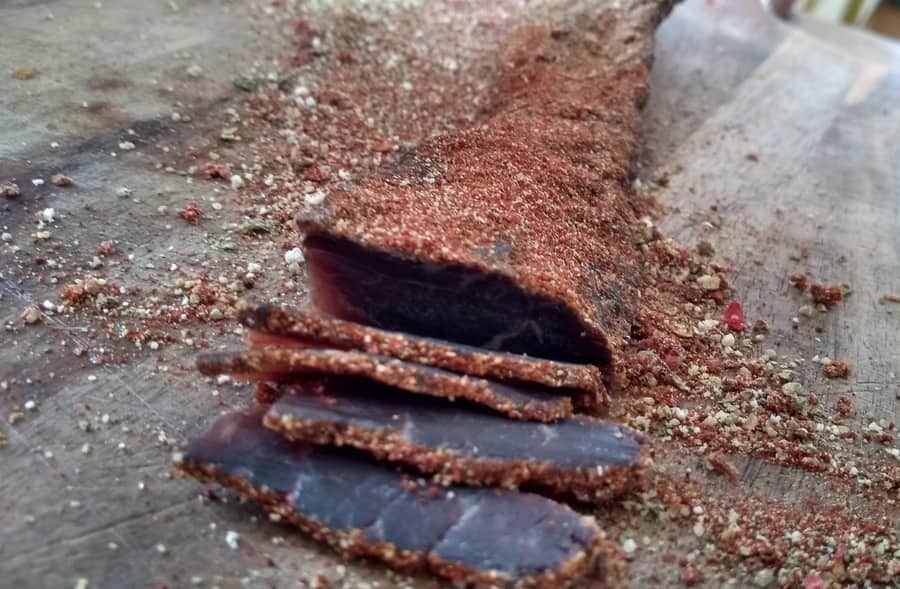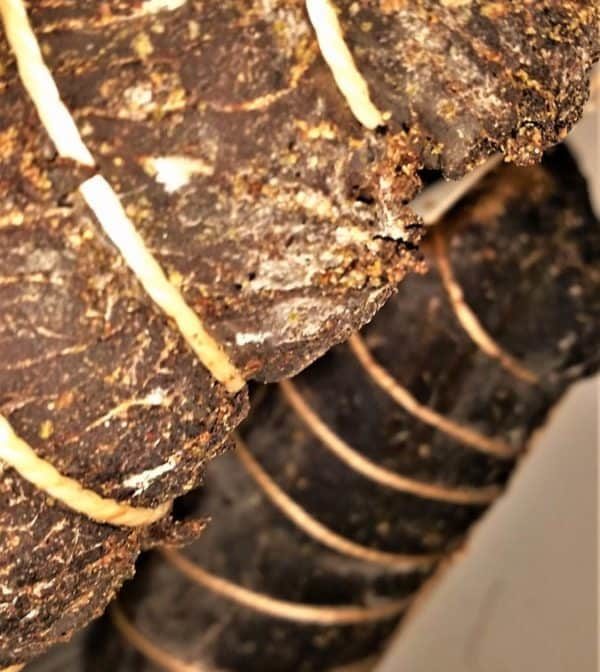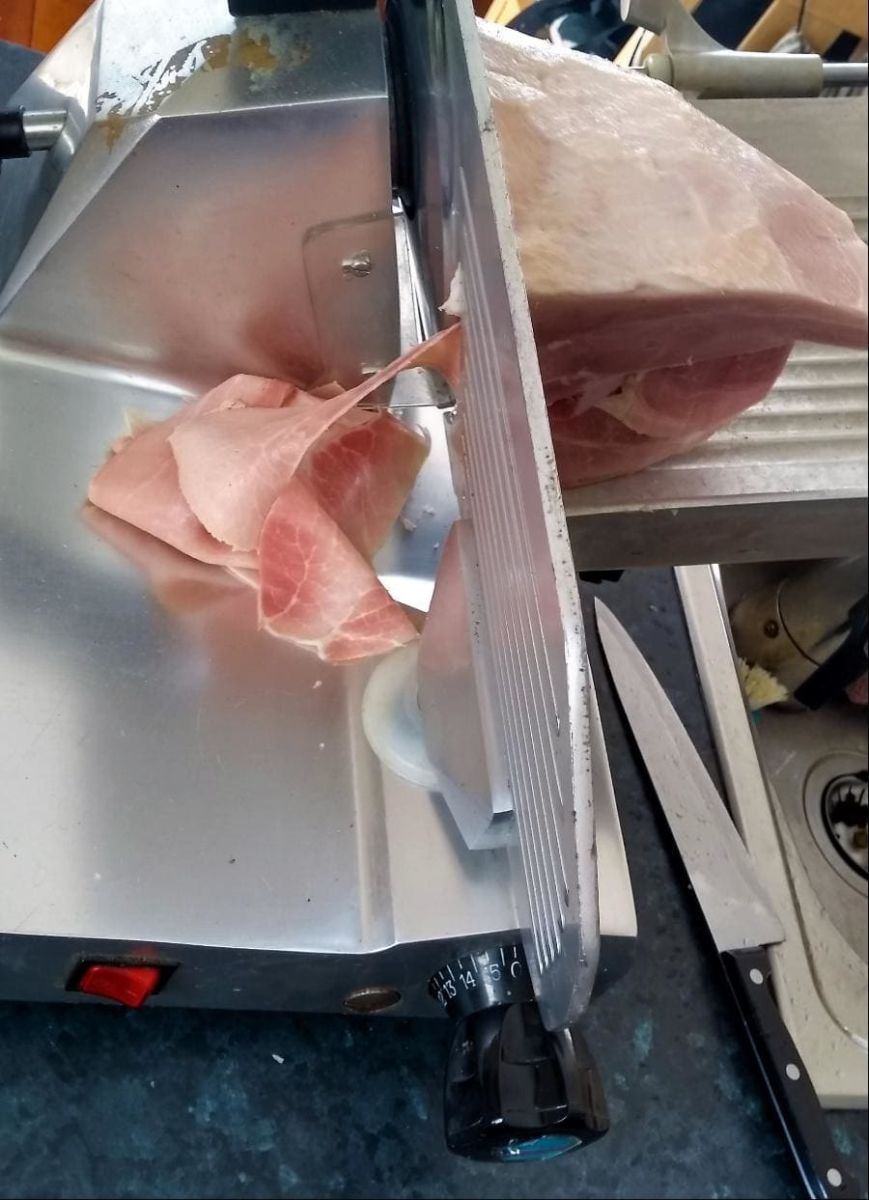Below is a clear, practical guide on whether different cured and charcuterie meats require refrigeration, as well as how I store them to maintain their optimal flavor. I’ve organized this by product type with a quick-reference table, then deeper notes for each style.
Storage tips:
- Keep whole dry-cured meats intact for longer preservation.
- Store sliced meats in airtight containers or wrap them well to minimize oxygen exposure.
- Use stated dates on commercial packs; once opened, plan to eat sooner.
- Refrigerate any sliced or opened meats to maintain freshness.
Cured meat is a broad category. Whether it needs refrigeration depends on the method (dry-cured vs. cooked/hot-smoked) and whether it’s kept whole or sliced. Below is the quick answer; further down, I explain the “why” for each type and how I handle it at home.
| Meat Product | Needs Refrigeration? |
| Dry-Cured, Cold-Smoked Meat — Packaged / Sliced | Yes |
| Dry-Cured, Cold-Smoked Meat — Whole / Homemade | Yes (or cool place) |
| Hot-Smoked Meat (e.g., Bacon, Chicken, Fish) | Yes |
| Biltong / Jerky (properly dried) | No |
| Dry-Cured Fermented Salami — Whole | Cool place or Fridge (Will Dry Out) |
| Dry-Cured Fermented Salami — Sliced | Yes |
| Whole-Muscle Salumi (Prosciutto, Parma, Lonza, Bresaola) — Whole | Cool place |
| Whole-Muscle Salumi — Sliced | Yes |
| Pâté / Rillettes / Confit (fat preservation) | Yes |
| Ham (Whole on the bone) | Yes (in a damp bag/cloth) |
| Ham (Sliced) | Yes |
Why whole cuts last longer than slices: whole pieces limit oxygen exposure, slow moisture loss, and better protect the surface. Slices expose more surface area, so they dry and dull faster. That’s why I keep salami or whole-muscle pieces intact as long as possible, and only slice what I’ll serve.
Cool place vs fridge: Traditionally, many dry-cured meats were stored without refrigeration. A consistently cool, dark environment can be fine for whole, well-dried pieces. The fridge generally extends freshness, especially for vacuum-packed chunks or anything you’ve already sliced. I still prefer refrigeration for opened retail packs and for most modern household setups.
About “opened” timeframes: once oxygen hits the surface, flavor fades and quality drops more quickly. Commercial packs often estimate 5–14 days after opening; my own approach is to portion, wrap, and use quickly rather than letting large amounts sit exposed.
My simple test before serving: I always look and smell first. It’s normal for properly dried pieces to firm up over time. If something smells “off” or shows unusual discoloration or textures, I don’t serve it. This is a practical kitchen habit, not medical advice.

How I Store Different Cured Meats
Below, I break down each style based on its production method (dry-cured vs. hot-smoked/cooked) and whether it’s whole or sliced. This helps you decide where the fridge is essential and where a cool place can work for intact pieces.
Cold-Smoked Meat — Packaged / Sliced
Refrigerate? Yes.
Cold smoking is a drying-and-flavoring step performed at low temperatures. Once something is sliced and packaged, the protective benefit of being whole disappears. If I open a commercial pack, I reseal and refrigerate promptly and plan to use it within a week or so, depending on how it looks and smells and what the pack suggests.
Cold-Smoked Meat — Whole / Homemade
Refrigerate? Yes — or a consistently cool place can be fine for well-dried, intact pieces.
Whole, well-dried slabs (speck-style pieces, cold-smoked pancetta, or whole salmon fillets that have lost a good amount of moisture) are more robust. I still prefer refrigeration for long holds, especially for vacuum-packed chunks; but if I’m eating through a piece steadily and it’s cool, I’ll keep it wrapped, out of light, and slice only what I need.
Hot-Smoked Meat (Bacon, Chicken, Fish)
Refrigerate? Yes (these are cooked).
Hot smoking cooks the meat. I treat it like any cooked product: refrigerate promptly, portion if needed, and freeze for more extended storage. Once opened or cooked at home, I aim to use it within 7–10 days, or freeze portions to avoid waste.
Biltong and Jerky
Refrigerate? Generally, no (if properly dried).

Biltong and jerky are dried until moisture is low enough that bacteria can’t thrive. That’s why they’re such reliable travel or hiking foods. I don’t refrigerate mine unless it’s a softer style or not fully dried. In that case, refrigeration can help slow additional drying or spoilage.
If you’re buying commercial jerky, you’ll notice best-before dates and “consume within X days” once opened. My own homemade biltong has lasted weeks stored in a paper bag, and it just gets chewier with time. For an official angle, here’s USDA guidance on jerky storage.
Dry-Cured Salami (Whole vs Sliced)
Refrigerate? Whole: A cool place can be fine. Sliced: Yes.

Whole salami can be hung in a cool place (under 16 °C / 60 °F) and will continue to slowly dry. I often keep mine in the fridge if I want it to dry quicker in a slightly more humid environment. Once cut, salami exposes more surface to oxygen and needs refrigeration to avoid spoilage.
Here’s a more detailed breakdown I wrote on how long whole vs cut salami lasts, if you want specifics by style. Generally, I find whole pieces last months, while sliced salami lasts a couple of weeks in an airtight container.

Whole-Muscle Salumi (Prosciutto, Parma, Lonza, Bresaola)
Refrigerate? Whole: cool place is fine. Sliced: Yes.
Whole legs of prosciutto or lonza are designed to be preserved. In Italy or Spain, they’re often stored at room temperature in cool, dark cellars. Once sliced, though, I keep everything in the fridge and use it within a week or two for best flavor.
If you’re planning a spread, I built a charcuterie per-person calculator to help decide how much prosciutto or bresaola to slice in advance. Keeping the bulk intact is always the best way to protect aroma and texture.
Want to dive deeper into what cured meat really means and why it keeps without cooking? See my guide on what cured meat means and how it works. It also explains how salt and drying create an inhospitable environment for harmful bacteria.

As an external resource, I also recommend reading this quick guide on how to store a prosciutto leg at Eataly. It shows the traditional way Italians manage a full leg once it’s mounted on the slicer at home.
Pâté, Rillettes, and Confit (Fat Preservation)
Refrigerate? Yes.

Most pâtés and rillettes you buy are sealed with a layer of fat or butter to block oxygen. Once that seal is intact, they last a while. As soon as it’s broken, I find that they only last about a week before the flavor fades and the texture changes.
Confit, such as duck legs cooked and stored under their own fat, can last longer — I’ve kept wild duck confit for two to three weeks in the fridge, provided the fat layer fully covers the meat in the jar. Always keep these airtight and cold.
Ham (Whole or Cut)
Refrigerate? Yes — wrap in a damp cloth or ham bag, cut in an airtight container.

Country ham and bone-in hams have been salted and smoked, so they last well. A ham bag helps stop them drying out too quickly in the fridge. I don’t own a bag, so I simply use a slightly damp tea towel, which does the job just as well.
Sliced ham is more delicate — I put mine into airtight containers and aim to finish within a week. Otherwise, it develops that slightly “off” texture and aroma that tells me it’s past its best.
Fridges Came Long After Cured Meat
It’s worth remembering that most dry-cured and cold-smoked meats were invented centuries before refrigerators. Sailors carried them on long voyages as a stable protein source, and villages hung them in cool spaces for months at a time. Salt, smoke, and drying were the “technology” that kept meat safe.
What has changed is commercial processing. Some supermarket bacon, for example, is injected with water to increase weight, which explains the puddle in the pan when it fries. Traditional dry curing doesn’t have that problem — the salt draws out moisture instead of adding it back in.
FAQs on Refrigerating Cured Meat
How should I store sliced dry-cured meats to maintain freshness?
Store sliced dry-cured meats in butcher paper or an airtight container. Keep in the fridge once the package is opened. They spoil faster than whole pieces, so I use them within a week or two.
Do whole dry-cured meats need refrigeration?
Whole dry-cured meats like prosciutto or salami don’t always need refrigeration if kept in a consistently cool place (below 18–20°C / 64–68°F). Still, refrigeration slows drying and extends freshness, especially for vacuum-packed chunks.
What’s the best way to store hot-smoked meats like bacon or salmon?
Hot-smoked meats are cooked and always need refrigeration. Once opened, they last about 7–10 days. Freezing is a good option if you want longer storage.
How long does biltong or jerky last without refrigeration?
Biltong and jerky are dried to the point they don’t need refrigeration. I’ve kept mine for weeks in paper bags. If you want to slow additional drying, refrigerate them in a container.
What’s the safest way to store whole prosciutto or Parma ham?
Keep whole prosciutto or Parma in a cool place away from light. Once sliced, refrigerate the cut portion and wrap well to protect flavor. For a traditional approach, see guides on how Italians manage a leg mounted on the slicer.
If you’ve got your own storage tricks or questions about keeping cured meats fresh, drop a comment below — I’d love to hear how you handle yours.

Tom Mueller
For decades, immersed in studying, working, learning, and teaching the craft of meat curing, sharing the passion and showcasing the world of charcuterie and smoked meat. Read More

Hi Tom – thanks for the article. I have a question. If I have a whole leg of prosciutto and I have started to slice off it (but obviously haven’t polished the whole leg in one sitting) what is the best way to store the leg that has been cut into? Thanks, Chanel
Hi Chanel,
That’s awesome, a whole leg! In many parts of Europe, these are kept at ‘room’ temperature, but that depends on what your room temperature is!
Lets say 12-20 Cel or 53-70 Far.
It’s basically ‘preserved’, so you can just slice off wafer thin slices for months. keep as much skin/fat intact to protect the meat.
Putting it in the fridge (which is a dry environment), will mean it will dry out faster and isn’t ideal.
Hopefully the slicing is working, if you need some more advise, check out this slicing post I wrote . https://eatcuredmeat.com/how-to-thinly-slice-cured-meat/
All the best,
Tom
Hello Tom,
What if I need to store not sliced meat/sausage for a long period of time? Will it dry out in the freezer being kind of vacuum sealed (I don’t have a vacuum sealer but there are techniques to accomplish that? Regards
sausage? if fresh sausage freezing is what I use.
If charcuterie salami unsliced and dry-cured can be hung in room temperature since it is preserved it may dry slightly. Same with whole muscle meat unsliced like pancetta or braesola. In the fridge will dry it out too much! Putting it in a container will not give good results either (1 week maybe, gets slimy).
I have had a friend freeze parma ham, defrost and bring on a camping trip (didn’t need to be frozen). Once thawed it was fine!
Hi Tom.
I was curing my own bacon, in the fridge, but the door didn’t close properly. It was like that for 3 days. It’s being cured in plenty of salt and
Sugar. The doors now closed but I was wondering if it’s safe or if I should ditch it.
Hey Leigh, a little vague to assess in detail. If it was me, I trust my senses – nose mainly! If I don’t feel completely safe from a good sniff. It gets the Biff! (thrown out!)
Not worth risk personally.
Cheers Tom
I bought some linguica from a butcher… like a 1#link, wrapped on deli paper, and left in fridge for 3 weeks. Is it still good? Is it unsafe to cook and eat?
I googled that sausage, its fresh and smoked I think. If it isn’t fully cured and dried – I wouldn’t eat it. On honest food website, the recipe says its should last 5 days in the fridge….
Sounds similar to Calabrian Italian or Chorizo styles!
Hi
I make home made salami (7 yrs ) and Hang it out in garage to dry naturally then I vacuum seal them whole and store in cupboard . I then use as needed. They last ages.
In regards to the bresaola can I do the same or do I need to vac seal and store in fridge and what shelf life will it have
I am also doing capicola
I am using the UMAii system
Hey there, yes Umai makes it alot easier, different approach then balancing mold cultures with a DIY curing chamber!
Braesola is whole muscle and more straightforward then salami since less exposure then mincing for salami.
Hard to tell from a few sentences, but if it was me, sounds pretty good. Umai first then vac seal fridge is safe, depends on your ‘cupboard’ temperature!
You just want to cut that whole muscle meat ultra wafer thin when its ready (info on deli slicer here)
Hi Tom
I am just about ready to slice my bresaola in a couple of days as it will meet the required weight lose
Can I vacuum seal and refrigerate and will it keep like salami? I’m thinking yes
Also I am ready for my capicola as well
The problem I have is that I have got 2
one of them has great contact with the bag and the other not so great
The one that has great contact is 100 gm from weight to cut
The other is 400 gm
I have re vacuumed a couple of times and it still has not a good contact
There is no smell and no black to it
It still looks great
I’m thinking I just wait a bit longer?
Any thoughts or advice ?
Hey there, definitely can vac pac once 30-40% weight loss. I don’t know your setup so its hard to comment though.
Not sure what great contact means?
Waiting is always key with this craft!
Bought some cured salami sticks, dried and vacuum sealed, in Italy. They have been stored in the refrigerator. How long are they good in there for?
SO much variation! best before date?! 🙂
If it was dry cured Italian style salami, you can easily go 6 months or years potentially in my experience. If it has the white powder (penicillin) some people find this can alter taste.
Just eat it! salut!
Hi Tom,
i’m installing a wine room, will be air conditioned to a level 16 C, and will naturally drop to about 15 C during winter. Will this be a good place to hang/store meats? Cheers, David
Has potential! Once you get that good mold going I think so. I know of a few meat curers who have glorious wind rooms with dry cured meats as well! Moisture 70-80% and some airflow is also useful, the ebook on the courses page give you a rundown on conditions. Cheers Tom
Hi, Tom! I want to send to friends some cured pork loin and gravlax. I plan to send it, vacuum sealed in a box with refrigerant gels and in overnight shipping. Is it safe?
I would do the same, sounds good 🙂
My neighbor brought over a gift for Christmas and told me it was a do it yourself meal. Quote- She said it had been salted or something like that for 7 days of needs 7 days not sure – Unquote. So I said what do I do then, she didn’t know. I figured it was something like dry goods that had all the ingredients measured up. It was wrapped in a box with a Brown flat paper bag on top, okay I thought brownies. Wrong it was fun steak that way out 3 days. Are they still good?
Hey, very hard to tell from a description! Either salt for seasoning or salt for curing. If they said cook it, it’s not ‘dry curing’ it take weeks/months to dry out a salted chunk of meat. If it’s biltong or jerky that’s diff again!
Not enough detail soz
Hi Tom, I live in Italy and although I am married to an Italian he has no idea how to store cured meats. His family throws a dish towel over the top of the meat and leave it on the sideboard. They eat it daily and it’s finished pretty quickly! When meat is well-cured it seems to work well to vacuum seal it, but when it’s a bit ‘soft’ to the touch (and doesn’t slice easily) I feel like it needs to cure more/dry out a little? I’ve tried storing large chunks of prosciutto or a whole salami wrapped in in foil and then into a paper bag in the fridge, which seems to work fairly well. We recently stored a capocollo in the thick butcher paper in which it was purchased and then in an unsealed plastic bag in the fridge, but it molded. I’ve read suggestions to wrap in plastic wrap or parchment paper and then foil. Is there a foolproof way, or is it always hit and miss?
Hey there, yeah fridges always run dry, so they will dry meat out. As you know across Italy – most dry cured meats are just hung up around the house, norcini butcher or whatever. I’,m still perfecting finished dry-cured meats, which I try and remove all white penicillin mold and then vac pac. I have had an uncouth friend freeze Parma Ham, and brought it on a hunt… It was fine actually! He really did treat it like a hot-smoked ham though!
We were lucky enough a few years across to spend 3 months driving North to South in Italy – most houses we stay in they just kept it in the fridge, in its ‘wrapping’ – thicker bits take longer to dry. Fat takes much longer then meat.
Hi!
Just wondering- I heard you can store dried salamis in sifted wood ash. Do you know anything about this? How long can the meats ne kept in ashes? Will they dry out? Do you think I can do this with all whole cuts (coppa, pork belly, etc?
Also, have you ever heard of keeping dried salamis and all in the freezer ? Would that not change the consistency of the meat? What is your opinion?
Thanks!!
A rough hunting buddy brought frozen parma ham (yes parma ham the real stuff) hunting with us. It was fine, vacpac meat without mold and storing in curing or normal fridge is generally what I do. As you can imagine it’s locked the level of moisture, so it equalizes the dryness and continues to age nicely!
Ash? no idea! will have to try it! Would love to hear of the results too!
Hi Tom, I bought a package of Gusto brand genoa mild salami (it’s slices)– it is in a vacuum sealed type of package. I forgot to put it in the fridge when I got home. It’s unopened and has been unrefrigerated for 2-3 weeks. I’m guessing it is fine to eat… but I can’t find anything online that would clarify that. It doesn’t even say refrigerate on the package…
I’m just really curious. Any thoughts? Thanks a lot!
Hey there, depends on the temp around your home! And acidity, salt, and a few other factors – too many factors to give any advice.
Don’t risk it for the biscuit!
what about dry cured Bresaola…..there is no fat and I have a piece thats 2.5lbs. Sliced tin it makes the best carpaccio with arugula and some shaved parmigiano. Anyway i wrap it in plastic wrap then a zip lock bag but how long do you think it will keep refrigerated or should i freeze?
Many I have seen with whole braesola keep it in the fridge (in Italy – antipasti most nights 🙂 ), a few months at least I reckon. But it also depends on your room temperature, might be fine to just hang.
Wouldn’t freeze, it’s preserved already due to its weight loss
Hi, ive got some leftover sliced parma ham, pancetta and salami. I vacuumed packed them separately. How long normally can it last inside the refrigerator? Thanks in advance for the info!
6-12 months or more! Educated Guess! I normally don’t slice. But eat/scoff it within 6 months, that’ what I would do!
Hi. I have some vac-packed sliced salami that I bought yesterday and forgot to put in the fridge until this morning. It was left out overnight for around 17 hours at around 19 degrees. Will it be ok? Thanks!
probably, if its dry cured properly Cheers
I made krakowska last night. It’s a Polish pork sausage with a combination of ground, emulsified, and chunks of meat. I cured for roughly 36 hours, then smoked for 12 hours starting at 120f for the first 3 hours and then 150-180f for the remaining time until I hit an internal of 156f with very little moisture loss. After that, it hung in the basement at around 14-15c for 24 hours. My question is can I continue to hang the sausage at those temperatures and for how long? I’ve cut into one already, so obviously that needs to go in the fridge, but I’m wondering about the whole one as I’m hoping to let it dry down to roughly 30% moisture loss.
Haven’t made Krakowska, from what I know it is cooked/ hot smoked/baked so weight loss is irrelevant? Cheers T
I am interested in preserving wild meats
Please find these links:
https://eatcuredmeat.com/how-to-cure-wild-game-meat-know-how-pictures-tips/
https://eatcuredmeat.com/how-to-preserve-meat-with-salt-smoke-fat/
https://eatcuredmeat.com/how-to-cure-wild-game-meat-know-how-pictures-tips/
Hi Tom i brought some black pig cured ham from a lovely farm in the lot-et-garonne it’s vacuum sealed. But without a date, i’ve kept it in the fridge for the last 2 months do you think it will be ok to eat at Christmas ?
Bayonne ham? Jambon? It’s French ver. of prosciutto. vac packed I’ve had prosciutto (homemade) for 5 years vac packed! (slicing off a bit and resealing every now and then 🙂
Tom